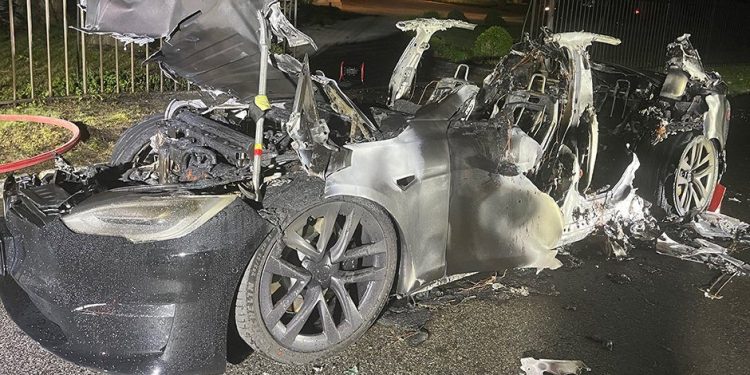Tesla’s less likely to catch fire than traditional cars, says Tesla
Plenty has been written about electric cars and fires. Just this month General Motors confirmed a huge sweeping recall for all of its Chevrolet Bolt EVs over potential fire risk. In the same month, details came to light about a Tesla Model S bursting into flames while being charged as the owners slept.
Now, Tesla has released its 2020 Impact Report, which aims in part to rebuke any claims that its products are more likely to spontaneously combust relative to traditional internal combustion vehicles.
The report makes the incredible claim that Teslas are 11-times less likely to catch fire than their petrol and diesel counterparts, based on figures in the US.
To come to this conclusion, Tesla used information sourced from America’s National Fire Protection Association and Department of Transportation. It used figures from these groups to calculate numbers of fires based on miles travelled. Tesla’s report says that 190,000 vehicle fires occurred in the US in 2019 alone.
“From 2012 to 2020, there has been approximately one Tesla vehicle fire for every 205 million miles travelled. By comparison, data shows that in the US there is one ICE [internal combustion engine] vehicle fire for every 19 million miles travelled,” says Tesla in its report.
“In the rare instances where Tesla vehicles are involved in a fire, we provide detailed information to first responders so they can safely handle those emergency situations. We continue to improve our battery chemistry, cell structure, battery pack structure and vehicle passive safety in order to decrease fire risk to as close to zero as possible.”
Tesla’s reporting is clearly at least partially motivated by the amount of reporting on Tesla fire incidents. It suggests that the amount of stories about its cars catching fire has created a “misconception”, adding that “when the media reports a story about a vehicle fire, it is usually reporting on an EV fire.”
“This is likely a result of the novelty of EV technology, rather than the prevalence of EV-related fires compared to ICE vehicle-related fires. The reality is, when compared to Tesla vehicles, ICE vehicles catch fire at a vastly higher rate,” it says.
The problem with the Tesla report is that it doesn’t seem to acknowledge anything about vehicle age. Tesla is a relatively young company. Those working in the motoring press generally have a particular interest in new cars. If a 20-year-old car catches fire, it’s less likely to be because of a production defect and more likely to be down to poor maintenance, abuse, or wear and tear.
While Tesla claims that it’s unfairly targeted by the media and that the media don’t often write about other manufacturers about fire incidents, it does not explain the amount of stories that get written about mainstream car brands issuing fire risk recalls. Along with GM’s recent Bolt recall, Hyundai has faced numerous fire-risk recall stories in the recent past, as have Kia, BMW, and others.
Over the years, the media has led numerous incredible campaigns against fire risks in internal combustion engine vehicles. The most famous of these was that of the Ford Pinto, a car that became infamous for combusting in rear-on collisions resulting in at least 500 fire deaths, some occurring after relatively minor impacts.





